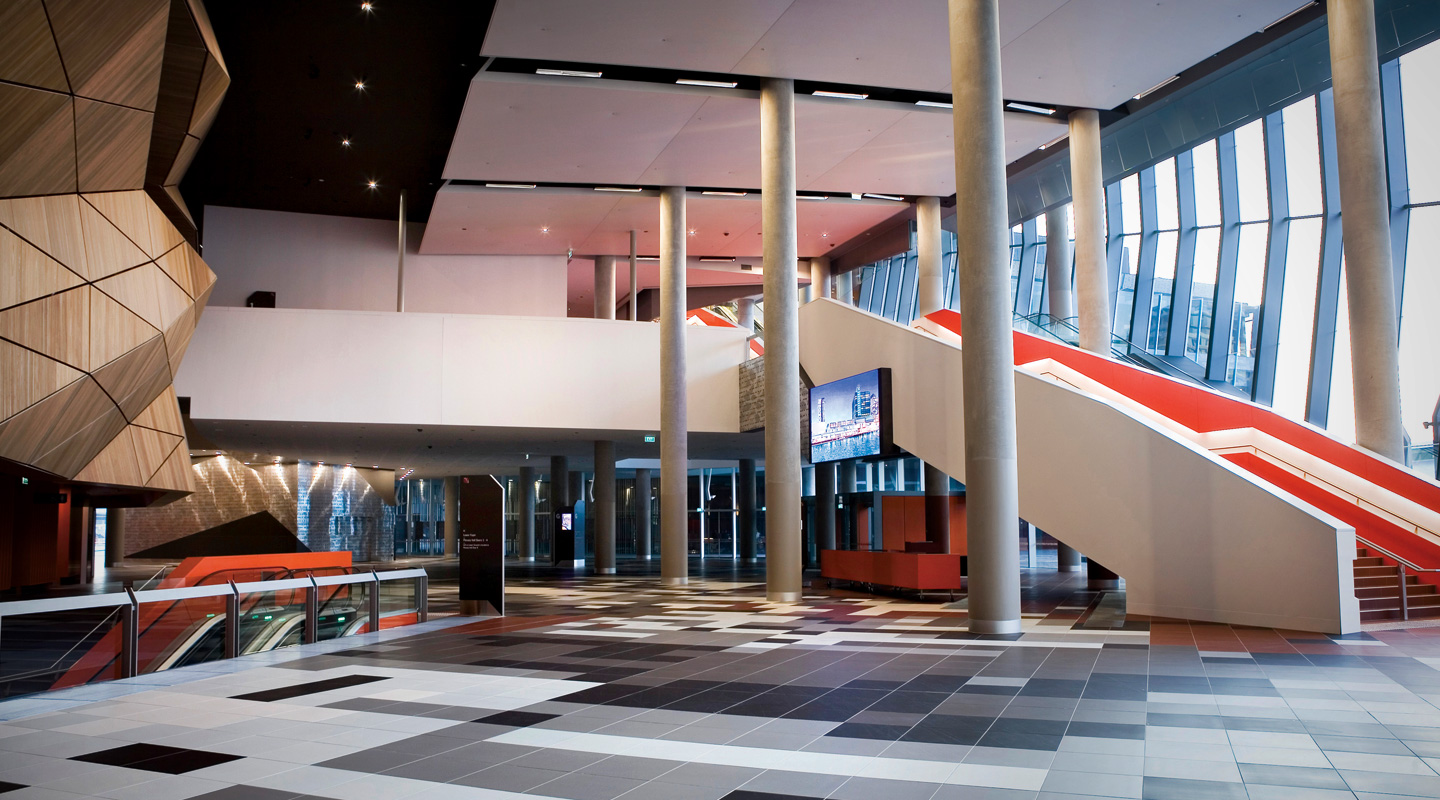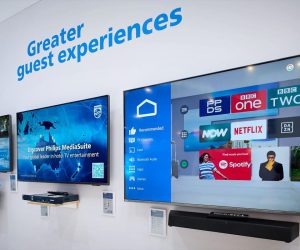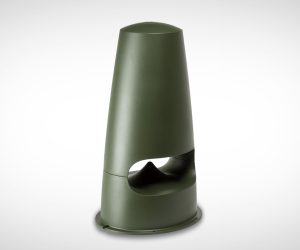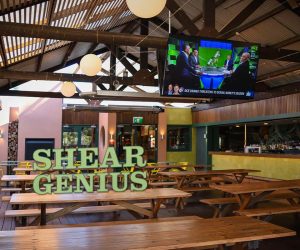
Adding Fibre To The Menu
A fibreoptic digital media network upgrade to Melbourne Convention and Exhibition Centre is realising the AV team’s original hi-def vision.
Text:/ Andy Ciddor
The Melbourne Convention and Exhibition Centre (MCEC) has an unusual relationship with its owners, the Victorian state government. Rather than merely being a profitable venue hosting conventions, events, trade shows and exhibitions, its primary role is to bring business to the state and every aspect of its extensive operations is focussed on that goal.
In place of the usual approach of eking out just a couple more years of operation from infrastructure and equipment that’s nearing the end of its profitable life, the philosophy at MCEC is to look for the business advantage in making pre-emptive improvements and upgrades. The advances are harnessed to build better relationships with existing clients and to seek new clients who are attracted to the facilities that the upgrades enable.
IN SOURCING THE AV
From the day MCEC opened, it has been the centre’s goal to provide the majority of clients’ technical facility requirements in-house. Essential facilities, such as simple PA, video projection/display, conferencing, lighting, staging and room control is part of the base hire for every one of the centre’s 42 meeting rooms. Even the banquet spaces and the plenary halls come equipped, configured and crewed with sufficient facilities for a broad range of activities before any additional client cost or intervention is required. While third-party hire and production companies are welcomed, the included in-house facilities are usually more than sufficient for bread-and-butter meetings, seminars and conferences. What MCEC aims to offer is a simple, smooth and painless experience that enables clients to do what they want, without any perceived complexity. And as we’re all acutely aware, making things looks smooth and simple takes an awful lot of careful planning, configuration, support, maintenance and preparation for the blind intervention of Murphy’s Law.
ORIGINAL PROMISE
MCEC is big, the largest such venue in the southern hemisphere, with facilities spread across an extensive site. To minimise cable runs the facility is constructed as three clusters of spaces, each with a local control/machine room. The clusters are linked via redundant fibre rings to a central control room, allowing connections between any source and any display device on the site. Even so, some signal runs from individual meeting spaces to their control/server room are pushing at the limit of most copper cabling technologies.
In accordance with everyone’s best guess at the time of construction, the then-cutting-edge digital video network linking the lecterns, HD projectors, rack-mounted PCs and HD PTZ cameras in each space was based around Category 6 STP cable with a maximum bandwidth of 250Mbps per pair. In everyday use the video quality on some of the longer runs did not live up to expectations, so it was decided to limit video transmission to 720p60 (1280 x 720 non-interlaced at 60fps). This was not quite the HD/1080p60 (1920 x 1080 at 60fps) that MCEC had promised to its clients.

WAIT & BNC
In 2010, less than a year after the Convention Centre opened its doors, and after considering the available options for bandwidth, run length, and technological stability, the decision was taken to install a broadcast-standard 3G-SDI network (2.97Gbps) to deliver full-bandwidth uncompressed HD between the sources and displays in each room. Video transport between spaces was limited to 3G-SDI signal converted to either RGBHV (VGA) or RGBHV over DVI. The transition to SDI involved opening walls and pulling 75Ω coax cable from every video I/O point to its associated control/server room, a costly and time-consuming undertaking. To many of us with a long history in AV, it is ever-so-slightly ironic that modern, state-of-the-art, low-crosstalk shielded twisted-pair cable was being usurped as a video carrier by ancient and venerable coax cable terminated by BNC connectors.
Designed by SMPTE for high bandwidth broadcast applications, the 3G-SDI data stream may carry embedded stereo audio and image metadata, but it isn’t intended to handle the DDC (Display Data Channel, ie. EDID, HDCP, etc) negotiations between devices to arrive at suitable transmission formats. Hence all video feeds between spaces had no DDC capability and so required operator intervention every time a room was set up and every time a user brought in their own device.
Although optical fibre had been a technological contender for all video transport both during construction and at the point of the SDI upgrade, at the time it had simply not been cost-effective to purchase, install or configure at those points.
Since the 3G-SDI upgrade the demand for increasing resolution in video images continued to grow, while the range of resolutions, connection types, pixel depths, aspect ratios and frame rates on both sources and displays continued to proliferate with gay abandon. By now, the original concept of MCEC being a simple plug and play environment for clients had been abandoned and operator intervention was the modus operandi, requiring far more staff than had been anticipated to maintain the illusion of seamless operation.
ANYTHING TO ANYWHERE
In 2013, with MCEC’s first five-year capital equipment replacement cycle about to roll around, Michael Walker, infrastructure and equipment manager for technical services, started looking for replacements for some key pieces of equipment that would have a major impact on the clients’ experience and satisfaction in the venue.
Unsurprisingly the long-promised capability for any client to turn up for a presentation, put their device on the lectern and simply begin a session which could be shared anywhere in the MCEC was very appealing at a variety of levels, so a search for a new video distribution system was undertaken. This time around, optical fibre was a prime candidate. Not only does fibre have the bandwidth to handle 1080p60 and well beyond, but unlike the situation a decade ago when the venue was being designed, the terminating optoelectronics are now mainstream devices at realistic prices, with proven records of reliably delivering the goods. Opening the walls for fibre runs would be a one-off event because all that’s required to get more bandwidth out of the system at a later date is to update the terminating optoelectronics in meeting rooms and equipment rooms.
ROLLING OUT FIBRE
The extensive fibre system rolled out by Rutledge AV is based around AMX Enova DGX digital media matrix switchers, which include such capabilities as independent audio and video routing and distribution, native resolution scaling, embedded converting, transcoding, amplification, HDCP management, embedded Ethernet, analogue input encoding and twisted pair distribution. The I/O frames take media cards for single mode fibre (up to 10km), multimode fibre (up to 300m), DVI, HDMI and UTP. Standalone AMX DXlink transmitters and receivers provide the meeting room and device endpoints for the fibre network.
The current generation of Enova DGX is based on a 10gbps architecture which can handle uncompressed 4k/UHD video at 30fps, while the recently announced 100 series of Enova handles 4k at a full 60fps plus de-embedded audio and DSP processing. The switchers are controlled by AMX NetLinx NX protocol which enables them to be integrated into the existing facility-wide AMX control network.
ONE GOOD LECTERN DESERVES ANOTHER
One of the stand-out facilities at MCEC has always been its fleet of custom-designed lecterns that not only come with all the usual facilities like twin microphones, an AMX room control tablet, a built-in PC, remote USB sockets, a slot in the front for client artwork/branding, audio and video inputs, client laptop inputs and LED script lighting, but they also have dual cup-holders.
Now, the additional capabilities added to MCEC’s AV networks required a major redevelopment of the user interface for the wireless AMX tablets in each lectern, so a decision was made to upgrade all of the tablets to the AMX nine-inch Modero ViewPoint as part of the redevelopment. Not only are the new tablets higher in resolution, more responsive, brighter and faster than their predecessors, they are also connected directly to their LAN by Ethernet when docked into the lectern, only cutting over to the 5GHz wi-fi network when removed from the docking station. The previous panels connected only via 2.4GHz wi-fi and had connectivity issues under some circumstances.
ENOVA NETWORK
43 × AMX Enova DGX 16 × 16 enclosures, each loaded with:
4 × Enova DGX-I-HDMI – HDMI input boards with HDCP
4 × Enova DGX-I-DXL-MMF – Multimode fibre input boards
4 × Enova DGX-O-DXL-MMF – Multimode fibre output boards
4 × Enova DGX-O-HDMI – HDMI output boards with SmartScale
16 × Enova DGX-AIE – Audio Insert or Extract boards
1 × AMX Enova DGX 64 × 64 enclosure loaded with:
Enova DGX-I-DXF-SMS – Single Mode fibre input board
Enova DGX-O-DXF-SMS, – Single Mode fibre output boards
Enova DGX-I-DXL-MMF – Multimode fibre input boards
Enova DGX-O-DXL-MMF – Multimode fibre output boards
Enova DGX-O-HDMI – HDMI output boards with SmartScale
Enova DGX-I-HDMI – HDMI input boards with HDCP
Enova DGX-AIE – Audio Insert or Extract boards
Transmitters & Receivers:
122 × DXLF-MFTX-MMD – Multi-format Multimode fibre transmitters
118 × DXLF-HDMIRX-MMD – HDMI Multimode fibre receivers, duplex

FULLY COVERED WI-FI
MCEC is rightly very proud of the extensive wi-fi capacity available to clients and visitors throughout its facilities, and has worked very hard to ensure that wireless coverage meets the peak load requirements and WAP handoffs are effectively seamless. During one large technical conference last year, the network was handling something in the vicinity of 70,000 simultaneous connection sessions. With those levels of wi-fi activity, it’s clearly safer to keep any critical control applications for meeting rooms well away from wi-fi (most especially 2.4GHz) wherever possible.
PROJECTOR UPGRADE: BOXER CLEVER
One other noteworthy upgrade in this round of equipment replacements is the projectors in the three sections of the plenary hall. The two HD Barco FLM14HD (14k ANSI lumens) projectors in the side halls and the HD Barco FLM18HD (18k ANSI lumens) projector in the main hall are being replaced by a trio of Christie Boxer 4K30 (4096 x 2160 at 30k ANSI lumens). These 3DLP projectors with 2 x dual 3G-SDI, 2 x Twin Displayport and HDMI inputs, are powered by six user-replaceable 450W mercury arc lamps, rather than the more familiar and ferocious Xenon arc.
MCEC is always pushing its technical infrastructure as a major selling point to the meetings and events industry and has recently won an international digital infrastructure award on the back of the fibre network upgrade. It’s refreshing to see a venue whose owners not only pay lip service to the idea that its AV facilities are critical to its operations, but actually puts its money where its PR mouth is, by committing to keep the facilities at the forefront rather than cutting critical corners.















RESPONSES